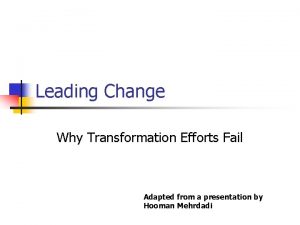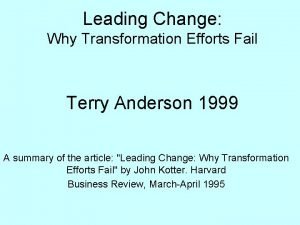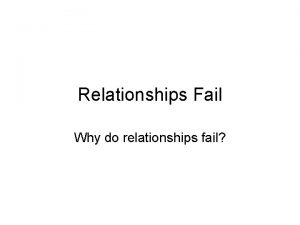Leading Change Why Transformation Efforts Fail Adapted from















- Slides: 15

Leading Change Why Transformation Efforts Fail Adapted from a presentation by Hooman Mehrdadi

Outline n The research n Eight common mistakes n Lessons to be learned

The research n n n More than 100 companies with different characteristics have been studied. The efforts have gone under many names. The result of changes

The research n In almost every case the basic goal was: “to make fundamental changes in how business is conducted in order to help cope with a new, more challenging environment”

Error #1: Not establishing a great enough sense of urgency n n n How most successful changes begin. Crises, potential crises or great opportunities. Over 50% have failed in phase 1, because of: n n Underestimating the need for motivating people. Overestimating their success. A lack of patience. A paralyzed senior management.

Error #1: Not establishing a great enough sense of urgency n n The need for a leader, CEO or division manager to sense urgency. Bad results are both a blessing and curse in first phase. An almost universal tendency to shoot the bearer of bad news. When is the urgency high?

Error#2: not creating a powerful enough guiding coalition n n In most successful cases a coalition is always pretty powerful. Senior management always forms the core of the group. More than a high sense of urgency is required. Reasons for failing: n n No history of teamwork at top. Expecting the team to be led by a staff executive.

Error#3: lacking a vision n n In very successful cases, a coalition develops a picture of future. A vision says something that helps clarify the direction in which an organization needs to move. A list of confusing and incompatible projects. A useful rule of thumb.

Error#4: Undercommunicating the vision n Three patterns with respect to communication: n n n Holding a single meeting or sending out a single communication. Making speeches to group of employees. Newsletters and speeches. Particularly challenging in case of short term sacrifices. Walk the talk, nothing undermines change more than wrong behavior by important individuals.

Error#5: not removing obstacles to the new vision n n Emboldened employees. Obstacles for employees: n n n Narrow job definitions. Compensation and appraisal systems. The action is essential both to empower others and to maintain the credibility of change effort.

Error#6: not systematically planning for and creating short term wins n n Most people go on a long march unless… In one or two years you should find: n n n Quality beginning to go up. Decline in net income stopping. Product introduction. Upward shift in market share. In successful cases managers actively plan to achieve objectives. They don’t hope for. The benefits of commitments to produce short-term wins.

Error#7: declaring victory too soon. n n n New approaches are fragile and subject to regression. Ironically, it is often a combination of change initiators and change resistors that creates the premature victory. What, instead of declaring premature victory.

Error#8: not anchoring changes in the corporation’s culture. n n In the final analysis change sticks when it becomes “ the way we do things around here” Two factor in institutionalizing change: n n To show people , the effects of new approaches. Make sure that next generation of top management will personify the new approach.

Lessons to be learned n n n Change process goes through a series of phases. Critical mistakes in any of the phases can have devastating impacts. A fewer errors can spell the difference between success and failure.

Reference n John P. Kotter, “Leading Change, Why Transformation Efforts Fail”, HBR , April 1995. Thanks for your attention
 Kotter why transformation efforts fail
Kotter why transformation efforts fail Bobbin leading principle
Bobbin leading principle Hey bye bye
Hey bye bye Fail am 435
Fail am 435 If you fail to plan, you are planning to fail
If you fail to plan, you are planning to fail Dont plan
Dont plan Leading change and organizational renewal
Leading change and organizational renewal Leading change and organizational renewal
Leading change and organizational renewal Nitcar
Nitcar Leading through change presentation
Leading through change presentation This passage is adapted from jane austen
This passage is adapted from jane austen Erythroposis
Erythroposis Adapted with permission from
Adapted with permission from In what ways have the highland maya adapted to modern life?
In what ways have the highland maya adapted to modern life? Xerophytes adaptations
Xerophytes adaptations Chaparral biome location
Chaparral biome location




























